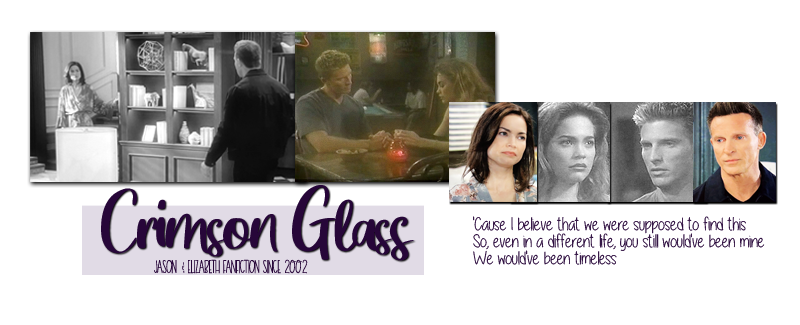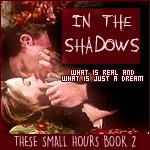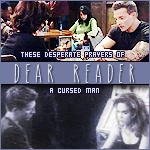What Is Three-Act Story Structure?
So that might seem like a straight forward question, but the concept and definition of three-act structure varies depending on who you ask. Some books (Book in a Month by Victoria Lynn Schmidt) break down the three act structure into incredibly small pieces: Plot Point, Story Hook, Climax, Resolution, etc.
The definition I’m offering here is an amalgamation of what I’ve learned reading all those books in order to best describe how I use the principles to structure my stories. It’s basically the idea of a beginning, a middle, and an end. In each section, there are few things that need to happen to propel your story forward.
In your beginning, you need have have the set up, the introduction of characters, the inciting incident, and at least one plot point that twists your story and pushes it forward.
In your middle, you have to take the situation you set up in the first part and raise the stakes–increase the tension, complicate the relationship. Your story should have a definable middle, or midpoint, to drive home how far you’ve come, and yet how far there is to go. And there should be another plot point that continues to push the story.
And in the end, you have to have your climax and resolution.
Those are usually the basics you need in any story. You can do more, you don’t always have to do all of the above — it’s structure that should be adapted to best suit your needs, but starting with the above is usually a good way to ensure that your story is relatively well-paced and does the minimum to keep your readers interested.
Discarding Earlier Versions: Poisonous Dreams
To discuss how I developed A Few Words, it’s easiest to start with the first version: Poisonous Dreams, which actually had an earlier discarded and unfinished version. It began as just a way to deal with the April 2003 spoiler that Elizabeth would be carrying Ric’s child.
I didn’t develop PD very much beyond the initial concept. I decided on a marriage of convenience angle which had Elizabeth marrying Jason to ensure protection from the Families and a layer of security with Ric. I didn’t develop Ric or the end of his relationship with Elizabeth, but rather jumped right into the plot. Version 1 opened with the wedding, and Version 2 opened with Carly suggesting the plan.
Why didn’t PD work? First and foremost, through characterization. The characters of Emily and Courtney and their use in the story was ill-thought out and only developed due to a need for an inside traitor. They both actively betray Elizabeth and put her into danger, which reflected how I felt about those characters in the summer and fall of 2003 rather than an accurate reading of how those characters might react.
Secondly, the story structure. Because I didn’t have an endgame in mind when I began PD, I couldn’t pace the story very well. I would throw in haphazard cliffhangers because I didn’t know what to do next, and I didn’t really have a handle on the characters of Jason or Elizabeth or the progression of their relationship in the story. Peripheral characters were oddly used or perhaps a bit forced, particularly Carly and the Spencers.
So when I began to write a sequel, I couldn’t make it work because I felt as though I had a shoddy foundation. I abandoned the sequel twice and decided to rewrite it.
The Structure and Development of A Few Words Too Many
A Few Words is divided into three parts, each of which have a breakdown of important story beats.
Part 1
Inciting Incident: Elizabeth learns she’s pregnant by Ric, a man whose true nature has been revealed to her recently.
Turning Point One: Elizabeth is nearly kidnapped, necessitating that she move in with Jason for extra security.
Part 2
Raising the Stakes: Jason and Elizabeth begin to deal with their past problems.
Midpoint: Jason and Elizabeth make love for the first time.
Turning Point Two: Elizabeth tells Jason she’s leaving him after Ric is no longer a factor.
Part 3
Temporary Relief: Jason and Elizabeth finally discuss their future together.
Climax: Jason and Sonny arrive at the warehouse to rescue Elizabeth.
Resolution: Jason and Elizabeth become engaged.
If you read A Few Words, you might be able to ascertain that I’ve structured the story focusing less on the actual action than the relationship between Jason and Elizabeth. Part One is the beginning, as they struggle with Jason’s claim to be her child’s father, Part Two is a cautious reunion that doesn’t answer enough questions, and Part Three is the resolution to their future–of being a family.
One of the major complaints of the story–and it’s an apt one–that the angst level was too much. There was too much of Jason being an asshole, of Elizabeth being too afraid to deal with the future.
I developed the progression of their relationship almost in a backwards fashion. I had a vision of Elizabeth sitting in a rocking chair, telling Jason it couldn’t work. That they wouldn’t come together as a family until after the baby was born.
In order to do that particular plot, I had to figure out why they would wait so long. How could I draw out the main plot–with Ric and Faith–for that length of time? Could it tie together?
Characterization: Dear God, the Angst.
I went back to the drawing board to look at who Jason and Elizabeth were as characters at this point and time. I had picked up this particular story in the spring of 2003, with a few alterations to the period between her leaving in October and the beginning of April. This is mostly to deal with the out of character nature of the confrontation in Kelly’s, and the way Elizabeth had acted towards Courtney or approached her relationship with Ric. I also wasn’t a fan of how they dealt with Ric’s character. Rick Hearst is an amazing actor, but they overplayed his hand, and the things he did to Elizabeth that spring and summer has been my primary obstacle in enjoying them as a couple again.
So once I had made a few changes, I had to deal with the fact they had both dated other people during the period in which they were separated. I had eliminated Sonny firing Jason over Courtney because, as I’ve often commented, the arc of the Jason/Courtney relationship was all wrong. I didn’t mind a rebound relationship and I would have understood if they had developed it from that, but they had both characters completely ignore the people who came before. If you were a new viewer in February, you never believe Courtney would have stripped for AJ or that Jason would have allowed himself to blackmailed by Edward or work with Taggart to save Elizabeth.
But the concept of a rebound relationship on both their parts? That worked. Jason has a history of turning to something else to numb his mind. With Michael, he returned to Jake’s and either drank or rode his bike. With Elizabeth’s defection, he looked to Courtney, someone who didn’t seem to expect too much of him. For Elizabeth, Ric really did represent the things Jason did to her–with the addition of pretending to respect and value her.
But establishing their characterization at the start of the story was easy. How to deal with a progression of those characters and what their baggage would mean if they gave their relationship an honest shot? The Zander nonsense from the previous summer still had to be dealt with, Elizabeth’s own general sense of inadequacy was also a factor. But what would really explain Jason holding himself back from Elizabeth and her child?
One of Jason’s defining moments as a character, aside from the aftermath of the accident, was his relationship with Michael and the sense of devastation he experienced upon losing him. At the same time he lost his position of Michael’s father, he also lost Robin–one of his first touchstones in his short life. And he lost her through a devastating betrayal. A year later, he was betrayed again by two other people he trusted–Sonny and Carly. Jason had talked himself into being in love with Carly and Sonny was his family. To me, this betrayal was never dealt with. Jason just set it aside and left town.
So far in Jason’s life, all the people he’d cared for–save Emily–had betrayed him. Elizabeth had also not proved herself all that trustworthy–particularly in 2001, when she walked away from him and then the nonsense of 2002. So Jason, though a simple man who values truth, learned to hold himself back. Because the loss of Michael, and the betrayals of Robin, Sonny, and Carly, had left him bleeding in the snow. It was as close to a suicide attempt as I think Jason has ever come, though it’s never really been written that way–it has always struck me in that way.
So it made sense to me that he wouldn’t necessarily leap into being around another child, even though he’s claiming paternity. Even after he and Elizabeth start working out their problems, he still holds himself back, because he doesn’t expect Elizabeth to stay.
Why doesn’t Elizabeth see this? Why doesn’t the parallel of the situation strike her? First, she’s just too swept up in her own misery, and second, I think she would just expect Jason to know her better than that. To know that she would never allow him to be part of her child’s life without follow through. Which is why when it finally comes to a head after Cady’s birth, she’s hurt but she’s understanding. And Jason’s a bit sheepish about it, because it does sound ridiculous when it’s finally said outloud.
So that’s how I developed the progression of their story. There is an insane level of angst in their relationship. They deal with literally every obstacle I could throw at them — Zander, Ric, Courtney, the baby, the future, his job, even Lucky. Why did I go to that trouble?
Because once they’re together, before her kidnapping, it feels earned. They’ve gone through hell and back in the last year, but now they’re a unit, they’re a family. I knew I was writing a sequel, and I didn’t want anything left over to deal with in that. A Few Words is an angsty love story set against the backdrop of action and psychotic villains, but it never really strays from that initial center: Jason and Elizabeth are the heart of the story.
Developing The Beats of the Story
I wanted to retain the sense of Emily and Courtney as slight antagonists due to the nature of their relationship, but I did not want to repeat the problems in PD. Emily actively betrays Elizabeth to Faith in both earlier versions, while Courtney actually participates in the final kidnapping. This didn’t feel right, and I can’t really explain why I thought it would be a good idea.
But I wanted Elizabeth to be slightly isolated in the beginning of the story, partly to introduce Nadine as a solution to that, but also to further develop the relationship between Emily and Elizabeth. They’re close friends, yes, but it was always in context of their relationship to Lucky. They became close after Emily was blackmailed, but when Emily thought Elizabeth might be involved with Jason, she kind of flipped. Additionally, the show never addressed Elizabeth and Zander’s night in the summer of 2002.
So I wanted to retain the sense of Emily’s betrayal, and Courtney as the scorned ex seemed natural. But I wanted to do both points as somewhat more believable. So I changed Emily’s betrayal to be a bit more passive and accidental, and Courtney retained the more active role–but as an informant.
So Emily is the one that leaks Elizabeth’s pregnancy to Ric, which starts the chain reaction of Jason claiming paternity. She does this to help Elizabeth, to prove they’re still friends. And her second betrayal is accidental. She’s commiserating with Courtney about the state of her friendship with Elizabeth, her relationship with Jason, and talks about a hole in Elizabeth’s security.
Courtney’s betrayal needed to be a bit more active, but I drew the line at having her participate in Elizabeth’s kidnapping. The way I had set up the plot gave me the motivation I needed: Carly has shifted allegiance to Elizabeth, Sonny is more concerned with Elizabeth, and of course, Jason chose Elizabeth. Courtney wants a bit of revenge, and Faith offers her that. Courtney tells Sonny she wanted to matter, and this was how she did. So Courtney takes Emily’s place as an informer.
I think the rewrite was a lot closer to the characters of Courtney and Emily, but maybe less so to Ric and Faith. Because I wanted them off stage as a menacing shadow, I didn’t do much with either of them. I don’t know if that’s a mistake or not, but it worked for me at the time, and I think it gave the story a bit of mystery. That when Jason and Sonny realize after Elizabeth’s kidnapping–that this is part of Ric’s endgame–that there was a rhyme and reason for his drawing out the scheme for nearly a year, in playing cat and mouse with the business–it tied together what might have felt like a lot of loose ends and filler information. But that’s just me.
Sometimes story structure is having an ending in mind and exploring all the reasons why a character might act that way. Knowing that I wanted to draw this story out over a period of ten months, knowing that I didn’t want the Jason and Elizabeth relationship resolved until after Cady’s birth–it challenged me to explore motivations and character. To bring in Sonny and Carly as supporting characters who might serve as sounding boards to explain the delay, and to also contribute to their part in Jason’s damaged psyche.
To develop the relationship in fits and starts — beginning with Chapter 9, where they begin to put their friendship back together, to Chapter 14 where they have an argument about how he’s pushing her away, to Chapter 17 where Elizabeth tells Jason she’s leaving him, to Chapter 22 where Elizabeth painfully explains to Jason that she knows him and his job and loves him anyway–it was all leading up to that moment where Ric sends a birth certificate with his name scrawled in, so that Jason and Elizabeth could face that from a moment of strength. To remark that if Elizabeth and Cady had to disappear, that it wouldn’t be a question in Jason’s mind that he’d be going with her.
Conclusion
I don’t know how much of that rambling is actually useful. Maybe it offers some insights into the insane levels of angst, or maybe it might help someone else ask questions about their own characters. Sometimes the best stories happen when you ask yourself a what if question and apply to a variety of characters and timelines. For A Few Words and PD, I asked, How would Jason and Sonny protect Elizabeth and her child from Ric? How would that complicate their own lives? Who would this affect?
As you can see, I didn’t exactly sit down and develop a story structure by asking myself what is my inciding incident and what is my plot point? I sketched out a general story and because I asked myself a thousand questions as to how the characters might react, the structure filled itself out naturally.
Writing soap opera fanfiction is a different animal than regular fiction. I usually develop my premise and then come up with an idea with what the ending should be, then start backwards. How would I get those characters to this position? Exploring your character’s motivations through their background will often give you all the story beats you need. You just have to stop long enough to ask yourself the question.







